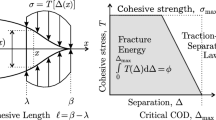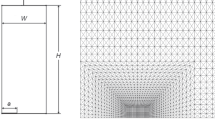Abstract
An extension of the Neuber-Novozhilov structural fracture propagation criterion is presented for mode I (tensile) and mode II (shear) propagation under compressive loads. In addition to allowing numerical simulation of crack growth, the criterion can be used to model change of propagation mode, crack branching, and coalescence. The criterion can be applied effectively when the SIF is calculated accurately (at least three significant digits). A numerical method is suggested for this purpose that consists of complementing the complex variable hypersingular boundary element method (CVH-BEM) with special procedures for automatically tracing crack propagation and coalescence. The CVH-BEM code with the structural criterion has been used to investigate crack propagation in compression for both small and non-small fracture process zone (FPZ). The results of numerical experiments are in agreement with the analytical conclusions available for the case of small FPZ that indicates the possibility of three distinct patterns of crack propagation under external compressive loads. These are: (i) smooth curvilinear tensile (wing) cracks, (ii) stair-step propagation pattern with changing modes, and (iii) in plane shear propagation. The numerical study also indicates that when the critical size of the FPZ is large enough, the non-singular terms in the expansion of the stress functions strongly influence the crack trajectories. Specifically, this occurs when the size of the FPZ approaches a quarter of the half-length of the initial crack. Calculations for a closed initial crack in a half-space under compression illustrate the general features of crack propagation. Although the dominant direction of crack growth is that of the applied compressive stress, the pattern of propagation strongly depends on the particular geometry, critical size of the FPZ, and the ratio of shear-to-tensile microscopic strength.
Similar content being viewed by others
References
Bobet, A. (2001). Numerical simulation of initiation of tensile and shear cracks. Rock Mechanics in the National Interest. Proceedings of the 38th US Rock Mechanics Symposium. Swets & Zeitlinger Lisse, Tinucci and Heasley eds., 731–738.
A. Bobet H.H. Einstein (1998a) ArticleTitleFracture coalescence in rock-type materials under uniaxial and biaxial compression Int. J. Rock Mech. Min. Sci 35 863–888 Occurrence Handle10.1016/S0148-9062(98)00005-9
A. Bobet H.H. Einstein (1998b) ArticleTitleNumerical modeling of fracture coalescence in a model rock material Int. J. Fract 92 221–252 Occurrence Handle10.1023/A:1007460316400
De Bremaecker, J.-C. and Ferris, M.C. (2005). Numerical models of shear fracture propagation. Eng. Fracture Mech., 2004 (in press).
J-C. De Bremaecker M.A. Ferris D. Ralph (2000) ArticleTitleCompressional fractures considered as contact problems and mixed complementarity problems Eng. Fract. Mech 66 287–303 Occurrence Handle10.1016/S0013-7944(00)00022-9
G.P. Cherepanov (1996) ArticleTitlePropagation of cracks in compressed bodies J. Appl. Math. Mech. (English translation of Prikladnaia Matematika i Mekhanika) 30 96–109
B. Cotterell J.R. Rice (1980) ArticleTitleSlightly curved or kinked cracks Int. J. Fract 16 155–168 Occurrence Handle10.1007/BF00012619
Dobroskok, A.A. (2003a). Numerical Simulation of Constitutive Equations for a Medium with Cracks and Contact Interaction. Ph. D. Thesis. Institute for Problems of Mechanical Engineering of Russian Academy of Sciences, Saint-Petersburg, (in Russian).
Dobroskok, A.A. (2003b). Crack growth near a free surface. Mathematical Modeling in Solid Mechanics. Boundary & Finite Elements Methods. Proceedings of the 20th International Conference. St-Petersburg, Postnov V. A. ed., 2, 184–187.
Dobroskok, A.A., Linkov, A.M., Myer, L. and Roegiers, J-C. (2001). On a new approach in micromechanics of solids and rocks. Mechanics in the National Interest. Proceedings of the 38th US Rock Mechanics Symposium. Swets & Zeitlinger Lisse. Tinucci and Heasley, eds., 1185–1190.
A.V. Dyskin (1997) ArticleTitleCrack growth criteria incorporating non-singular stresses: size effect in apparent fracture toughness Int. J. Fract 83 191–206 Occurrence Handle10.1023/A:1007304015524 Occurrence Handle1:CAS:528:DyaK2sXkvFyntb4%3D
A.V. Dyskin (1998) ArticleTitleStress fluctuation mechanism of mesocrack growth, dilatancy and failure of heterogeneous materials in uniaxial compression HERON 43 137–158
A.V. Dyskin L.N. Germanovich K.B. Ustinov (1999) ArticleTitleA 3-D model of wing crack growth and interaction Eng. Fract. Mech 63 81–110 Occurrence Handle10.1016/S0013-7944(96)00115-4
Germanovich, L.N., Ring, L.M. and Carter B.J. et al. (1995). Simulation of crack growth and interaction in compression. Proceedings 8th Congress on Rock Mechanics. Balkema, Rotterdam, Fujii T. ed., 1, 219–226.
Griffith, A.A. (1924). The theory of rupture. Proceedings 1st International Congress Applied Mechanics, Delft, 1924, 55–63.
H. Horii S. Nemat-Nasser (1985) ArticleTitleCompression-induced microcrack growth in brittle solids: axial splitting and shear failure J. Geophys. Res 90 3105–3125
A.R. Ingraffea F.E. Heuze (1980) ArticleTitleFinite element models for rock fracture mechanics Int. J. Numer. Anal. Methods Geomech 4 25–43
P. Isaksson P. Stale (2002) ArticleTitlePrediction of shear crack growth direction under compressive loading and plane strain conditions Int. J. Fract 113 175–194 Occurrence Handle10.1023/A:1015581922242
I.P. Isupov S.E. Mikhailov (1998) ArticleTitleA comparative analysis of several nonlocal fracture criteria Arch. Appl. Mech 68 597–612
M.L. Kachanov (1993) ArticleTitleElastic solids with many cracks and related problems Adv. Appl. Mech 30 259–445
J.M. Kemeny N.G.W. Cook (1991) Micromechanics of Deformation in Rocks S.P. Shah (Eds) Toughness Mechanics in Quasi-Brittle Materials Kluwer Academic Publishers the Netherlands 155–188
V.F. Koshelev A. Ghassemi (2003) Numerical modeling of stress distribution and crack trajectory near a fault or a natural fracture P.J. Culligan H.H. Einstein A.J. Whittle (Eds) Soil and Rock America 2003; 39th US Rock Mechanics Symposium Cambridge MA 931–936
Linkov, A.M. (1994). Dynamic Phenomena in Mines and the Problem of Stability. Int. Soc. Rock Mech., Lisboa, Cedex, Portugal.
A.M. Linkov (2002) Boundary Integral Equations in Elasticity Theory Kluwer Academic Publishers Dordrecht-Boston-London
S. Melin (1986) ArticleTitleWhen does a crack grow under mode II conditions? Int. J. Fract 30 103–114
Mikhailov, S.E. (1995). A functional approach to non-local strength conditions and fracture criteria. – I. Body and point fracture. II. Discrete fracture. Eng. Fract. Mech., 52, 731–743, 745–754.
S.G. Mogilevskaya L. Rothenburg M.B. Dusseault (2000) ArticleTitleGrowth of pressure-induced fractures in the vicinity of a wellbore Int. J. Fract 104 L25–L30 Occurrence Handle10.1023/A:1007637020233
N.F. Morozov Y.V. Petrov (1996) ArticleTitleOn the macroscopic parameters of brittle fracture Arch. Mech. Int. J 48 825–833 Occurrence Handle1:CAS:528:DyaK2sXjtFWhtA%3D%3D
S. Nemat-Nasser H. Horii (1982) ArticleTitleCompression-induced nonplanar crack extension with application to splitting, exfoliation and rockburst J. Geophys. Res 87 6805–6821
H. Neuber (1946) Theory of Notch Stresses J.W. Edwards Ann Arbor, Michigan
V.V. Novozhilov (1969) ArticleTitleOn a necessary and sufficient criterion for brittle strength J. Appl Math. Mech. (English translation of Prikladnaia Matematika i Mekhanika) 33 201–210
J.-P. Petit M. Barquins (1988) ArticleTitleCan natural faults propagate under mode II conditions? Tectonics 7 1243–1256
Q. Rao Z. Sun O. Stephansson C. Li B. Stillborg (2003) ArticleTitleShear fracture (Mode II) of brittle rock Rock Mech. Mining Sci 40 355–375 Occurrence Handle10.1016/S1365-1609(03)00003-0
O. Reyes H.H. Einstein (1991) ArticleTitleFailure mechanism of fractured rock – a fracture coalescence model Proceedings of the 7th International Congress of Rock Mechanics 1 333–340
A. Severin (1994) ArticleTitleBrittle fracture criterion for structure with sharp notches Eng. Fract. Mech 47 673–681 Occurrence Handle10.1016/0013-7944(94)90158-9
A. Severin Z. Mroz (1995) ArticleTitleA non-local stress failure condition for structural elements under multiaxial loading Eng. Fract. Mech 51 955–973 Occurrence Handle10.1016/0013-7944(94)00335-F
B. Shen O. Stephanson H.H. Einstein B. Ghahreman (1995) ArticleTitleCoalescence of fractures under shear stress in experiments J. Geophys. Res 100 5975–5990 Occurrence Handle10.1029/95JB00040
C.A. Tang P. Lin R.H.C. Wong K.T. Chau (2001) ArticleTitleAnalysis of crack coalescence in rock-like materials containing three flaws – Part II: numerical approach Int. J. Rock Mech. Min. Sci 38 925–939 Occurrence Handle10.1016/S1365-1609(01)00065-X
R.H.C. Wong K.T. Chau (1998) ArticleTitleCrack coalescence in rock-like material containing two cracks Int. J. Rock Mech. Min. Sci 35 147–164 Occurrence Handle10.1016/S0148-9062(97)00303-3
R.H.C. Wong K.T. Chau C.A. Tang P. Lin (2001) ArticleTitleAnalysis of crack coalescence in rock-like materials containing three flaws – Part I: experimental approach Int. J. Rock Mech. Min. Sci 38 909–924 Occurrence Handle10.1016/S1365-1609(01)00064-8
Author information
Authors and Affiliations
Corresponding author
Rights and permissions
About this article
Cite this article
Dobroskok, A., Ghassemi, A. & Linkov, A. Extended structural criterion for numerical simulation of crack propagation and coalescence under compressive loads. Int J Fract 133, 223–246 (2005). https://doi.org/10.1007/s10704-005-4042-4
Received:
Accepted:
Issue Date:
DOI: https://doi.org/10.1007/s10704-005-4042-4




